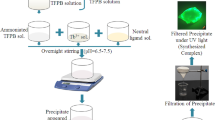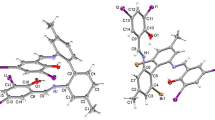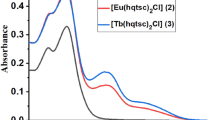Abstract
2,6-bis (benzothiazol-2-yl)-4-(tert-butyl) phenol ligand (HL) derived from o-aminothiophenol and 4-tert-butyl-2,6-diformylphenol was synthesized and characterized by using elemental analysis, FTIR, X-ray crystallographic analysis, 1H and 13C-NMR and UV–vis spectra. Its complexes with Cu (II), Ni (II) and Co (II) were prepared and isolated as solid products and characterized by elemental analysis, spectral techniques as well as magnetic susceptibility. The FTIR spectra showed that the benzothiazole-based ligand under investigation behaves as a bidentate ligand. The UV–vis spectra and magnetic moment data suggested an octahedral geometry around Ni (II) and Co (II) complexes, and tetragonal geometry for Cu (II) complex. Moreover, the evaluation of absorption and emission properties of the ligand and its complexes were carried out in different solvents. The ligand and its complexes showed absorption maxima in the range of 275 – 432 nm, and emission maxima from 367 to 581 nm in toluene, tetrahydrofuran and ethyl acetate.






Similar content being viewed by others
References
Karmakar T, Kuang Y, Neamati N, Baruah JB (2013) Cadmium complexes and cocrystals of indium complexes of benzothiazole derivatives and anticancer activities of the cadmium complexes. Polyhedron 54:285–293
Pettit GR, Kamano Y, Herald CL, Tuinman AA, Boettner FE, Kizu H, Schmidt JM, Baczynskyj L, Tomer KB, Bontems RJ (1987) The isolation and structure of a remarkable marine animal antineoplastic constituent: dolastatin 10. J Am Chem Soc 109:6883–6885
Aulakh VS, Ciufolini MA (2009) An improved synthesis of pyridine-thiazole cores of thiopeptide antibiotics. J Org Chem 74:5750–5754
Julliard JH, Douce R (1991) Biosynthesis of the thiazole moiety of thiamin (vitamin B1) in higher plant chloroplasts. Proc Natl Acad Sci U S A 88:2042–2045
Fuganti C, Rigoni R (1993) Penicillin acylase in the synthesis of aminothiazole cefalosporins. Biotechnol Lett 15:1163–1166
Ramalingan C, Balasubramanian S, Kabilan S, Vasudevan M (2004) Synthesis and study of antibacterial and antifungal activities of novel 1-[2-(benzoxazol-2-yl) ethoxy]- 2,6-diarylpiperidin-4-ones. Eur J Med Chem 39:527–533
Zitouni GT, Demirayak S, Ozdemir A, Kaplancikli ZA, Yildiz MT (2003) Synthesis of some 2-[(benzazole-2-yl) thioacetylamino] thiazole derivatives and their antimicrobial activity and toxicity. Eur J Med Chem 39:267–272
Karatepe M, Karatas F (2006) Antioxidant, pro-oxidant effect of the thiosemicarbazone derivative Schiff base (4-(1-phenylmethylcyclobutane-3-yl)-2-(2-hydroxybenzylidenehydrazino) thiazole) and its metal complexes on Rats. Cell Biochem Funct 24:547–554
Jain AK, Singla RK, Shrivastav B (2011) Thiazole: a remarkable antimicrobial and antioxidant agents. Pharmacol Online 2:1072–1084
Weidner T, Ballav N, Zharnikov M, Priebe A, Lonh NJ, Maurer J, Winter R, Rothenberger A, Fenske D, Rother D, Bruhn C, Fink H, Siemeling U (2008) Dipodal ferrocene-based adsorbate molecules for self-assembled monolayers on gold. Chem Eur J 14:4346–4360
Gilchrist TE (1992) Heterocyclic chemistry, 2nd edn. Longman/Wiley Harlow, Chichester
Arjunan V, Sakiladevi S, Rani T, Mythili CV, Mohan S (2012) FTIR, FT-Raman, FT-NMR, UV–visible and quantum chemical investigations of 2-amino-4-methylbenzothiazole. Spectrochim Acta A 88:220–231
Hall IH, Peaty NJ, Henry JR, Easmon J, Heinisch G, Purstinger G (1999) Investigations on the mechanism of action of the novel antitumor agents 2-benzothiazolyl, 2-benzoxazolyl, and 2-benzimidazolyl hydrazones derived from 2-acetylpyridine. Arch Pharm 332:115–123
Hutchinson I, Bradshaw TD, Matthews CS, Stevens MFG, Westwell AD (2003) Antitumour benzothiazoles. part 20: 3’-cyano and 3’-alkynyl-substituted 2-(4’-aminophenyl) benzothiazoles as new potent and selective analogues. Bioorg Med Chem Lett 13:471–474
Joseph J, Janaki GB (2014) Synthesis, structural characterization and biological studies of copper complexes with 2-aminobenzothiazole derivatives. J Mol Struct 1063:160–169
Abd El-Aziz DM, Etaiw SEH, Ali EA (2013) Synthesis, spectroscopic, cytotoxic aspects and computational study of N-(pyridine-2-ylmethylene) benzo [d] thiazol-2-amine Schiff base and some of its transition metal complexes. J Mol Struct 1048:487–499
Benazzouz A, Boraud T, Dubedat P, Boireau A, Stutzmann JM, Gross C (1195) Riluzole prevents MPTP-induced parkinsonism in the rhesus monkey: a pilot study. Eur J Pharmacol 284:299–307
Lara B, Gandia L, Torres A, Martinez-Sierra R, Garcia AG, Lopez MG (1997) Wide-spectrum Ca2+ channel antagonists’: lipophilicity, inhibition, and recovery of secretion in chromaffin cells. Eur J Pharmacol 325:109–119
Sakyan I, Logoglu E, Arslan S, Sari N, Akiyan NS (2004) Antimicrobial activities of N-(2-hydroxy-1-naphthalidene)-amino acid (glycine, alanine, phenylalanine, histidine, tryptophane) Schiff bases and their manganese (III) complexes. BioMetals 17:115–120
Yeap GY, Heng BT, Faradiana N, Zulkifly R, Ito MM, Tanabe M, Takeuchi D (2012) Synthesis, molecular structures and phase transition studies on benzothiazole-cored Schiff bases with their Cu (II) and Pd (II) complexes: Crystal structure of (E)-6-methoxy-2-(4-octyloxy-2-hydroxybenzylideneamino) benzothiazole. J Mol Struct 1012:1–11
Fu XB, Weng GT, Liu DD, Le XY (2013) Synthesis characterization DNA binding and cleavage HSA interaction and cytotoxicity of a new copper (II) complex derived from 2-(2’-pyridyl) benzothiazole and glycylglycine. J Photochem Photobiol A Chem 276:83–95
Freinbichler W, Soliman A, Jameson RF, Jamesond GNL, Linert W (2009) Kinetic study of the complex reaction between copper (II) and 2-(2’-hydroxy-3’-methoxyphenyl) benzothiazole. Spectrochim Acta A 74:30–35
Netalkar PP, Kamath A, Netalkar SP, Revankar VK (2012) Design synthesis and DNA binding activities of late first row transition metal (II) complexes of bi- functional tri– and tetratopic imines. Spectrochim Acta A 97:762–770
Etaiw SEH, Abd El-Aziz DM, Abd El-Zaher EH, Ali EA (2011) Synthesis spectral antimicrobial and antitumor assessment of Schiff base derived from 2-aminobenzothiazole and its transition metal complexes. Spectrochim Acta A 79:1331–1137
Maheswari PU, van der Ster M, Smulders S, Barends S, van Wezel GP, Massera C, Roy S, den Dulk H, Gamez P, Reedijk J (2008) Structure cytotoxicity and DNA cleavage properties of the complex [CuII (pbt) Br2]. Inorg Chem 47:3719–3727
Marjani K, Mousavi M, Hughes DL (2009) Synthesis and crystal structure determination of copper (II) and iron (III) complexes of 2-(2-pyridyl) benzothiazole. Trans Met Chem 34:85–89
Beloglazkina EK, Yudin IV, Majouga AG, Moiseeva AA, Tursina AL, Zyk NV (2006) Synthesis and electrochemical study of 2-(2-pyridyl) benzothiazole complexes with transition metals (CoII NiII and CuII). molecular structure of aquabis [2-(2-pyridyl) benzothiazole] copper (II) diperchlorate. Russ Chem Bull Int Ed 55:1803–1809
Leelavathy C, Antony SA (2013) Synthesis spectral characterization and biological activity of metal (II) complexes with 4-aminoantipyrine derivatives. Spectrochim Acta A 113:346–355
Zhang F, Lin QY, Li SK, Zhao YL, Wang PP, Chen MM (2012) Synthesis interaction with DNA and bovine serum albumin of the transition metal complexes of demethylcantharate and 2-aminobenzothiazole. Spectrochim Acta A 98:436–443
Koyama E, Yang G, Tsuzuki S, Hiratani K (2002) Synthesis of novel bis (benzoxazole) derivatives by tandem claisen rearrangement and their fluorescence behavior. Eur J Org Chem 2002:1996–2006
Ho KY, Yu WY, Cheung K, Che CM (1999) Blue luminescent zinc (II) complexes with polypyridylamine ligands: crystal structures and luminescence properties. Dalton Trans 1581–1586
Yang Y, Li B, Zhang L, Guan Y (2014) Triphenylamine based benzimidazole and benzothiazole: synthesis and applications in fluorescent chemosensors and laser dyes. J Luminescence 145:895–898
Chu Q, Medvetz DA, Panzner MJ, Pang Y (2010) A fluorescent bis (benzoxazole) ligand: toward binuclear Zn (II)–Zn (II) assembly. Dalton Trans 39:5254–5259
Bishop MM, Lee AHW, Lindoy LF, Turner P (2003) A comparative study of supramolecular assemblies containing N”-(5,6-dimethyl-1H-benzimidazol-2-yl) guanidine, 2-guanidinobenzimidazole and their Ni (II) complexes. Polyhedron 22:735–743
Bishop MM, Lindoy LF, Skelton BW, White A (2001) Proton controlled supramolecular assembly: a comparative structural study of bis (2-guanidinobenzimidazolo) nickel (II) with bis (2-guanidinobenzimidazole) nickel (II) nitrate and 2-guanidinobenzimidazole. Supramol Chem 13:293–301
Chai CLL, Armarego WLF (2009) Purification of laboratory chemicals, 6th edn. Elsevier, Oxford
Bruker (2012) APEX2, SAINT and SADABS, Bruker AXS Inc. Madison, Wisconsin
Sheldrick GM (1997) SHELXS97 and SHELXL97 University of Göttingen, Germany
Geary WJ (1971) The use of conductivity measurements in organic solvents for the characterisation of coordination compounds. Coord Chem Rev 7:81–122
Nakamoto K (1997) Infrared and Raman spectra of inorganic and coordination compounds. Wiley, New York
Netalkar PP, Netalkar SP, Budagumpi S, Revankar VK (2014) Synthesis, crystal structures and characterization of late first row transition metal complexes derived from benzothiazole core: anti-tuberculosis activity and special emphasis on DNA binding and cleavage property. Eur J Med Chem 79:47–56
Gulcan M, Zengin H, Çelebi M, Sönmez M, Berber İ (2013) 2,6-bis ((E)-((5-benzoyl-2-thioxo-4-phenylpyrimidin-1 (2H)-yl) imino) methyl)-4-(methyl) phenol and its metal (II) complexes: synthesis spectroscopy biological activity and photoluminescence features. Z Anorg Allg Chem 639:2282–2289
Gulcan M, Sönmez M, Berber İ (2012) Synthesis characterization and antimicrobial activity of a new pyrimidine schiff base and its Cu (II) Ni (II) Co (II) Pt (II) and Pd (II) complexes. Turk J Chem 36:189–200
Rendell JCT, Thompson LK (1979) Complexes of substituted benzothiazoles. Cobalt (II) copper (II) and zinc (II) complexes of 2,2’-o-phenylenebisbenzothiazole; a potential N or S donor ligand. Can J Chem 57:1–7
Lever ABP (1984) Inorganic electronic spectroscopy. Elsevier, Amsterdam
Sönmez M, Çelebi M, Berber İ (2010) Synthesis spectroscopic and biological studies on the new symmetric schiff base derived from 2,6-diformyl-4-methylphenol with N-aminopyrimidine. Eur J Med Chem 45:1935–40
Liu H, Wang H, Gao F, Niu D, Lu Z (2007) Self-assembly of copper (II) complexes with substituted aroylhydrazones and monodentate N-heterocycles: synthesis, structure and properties. J Coord Chem 60:2671–2678
Figgis BN, Lewis J, in: Lewis J, Wilkins RG (Eds.) (1960) Modern coordination chemistry: Principles and methods. Interscience, New York
Chandra S, Gupta LK (2007) Modern spectroscopic and biological approach in the characterization of a novel 14-membered [N4] macrocyclic ligand and its transition metal complexes. Trans Met Chem 32:240–5
Rosu T, Pahontu E, Maxim C, Georgescu R, Stanica N, Gulea A (2011) Some new Cu (II) complexes containing an ON donor Schiff base: synthesis, characterization and antibacterial activity. Polyhedron 30:154–62
Rosu T, Pahontu E, Ilies DC, Georgescu R, Mocanu M, Leabu M, Shova S, Gulea A (2012) Synthesis and characterization of some new complexes of Cu (II), Ni (II) and V (IV) with schiff base derived from indole-3-carboxaldehyde. Biological activity on prokaryotes and eukaryotes. Eur J Med Chem 53:380–9
Acknowledgments
The authors wish to thank Presidency of Scientific Research Projects of University of Yüzüncü Yıl for the financial support.
Author information
Authors and Affiliations
Corresponding author
Rights and permissions
About this article
Cite this article
Gulcan, M., Karataş, Y., Işık, S. et al. Transition Metal(II) Complexes of a Novel Symmetrical Benzothiazole-Based Ligand: Synthesis, Spectral/Structural Characterization and Fluorescence Properties. J Fluoresc 24, 1679–1686 (2014). https://doi.org/10.1007/s10895-014-1455-3
Received:
Accepted:
Published:
Issue Date:
DOI: https://doi.org/10.1007/s10895-014-1455-3




